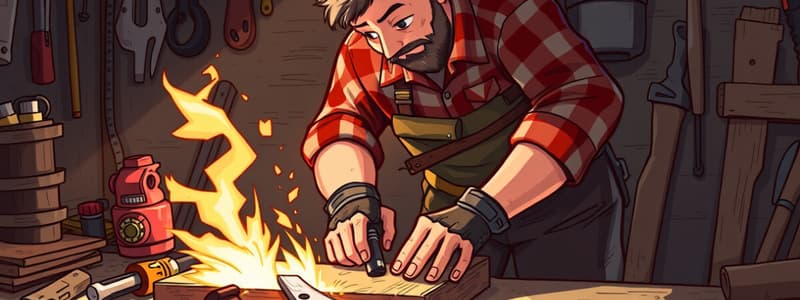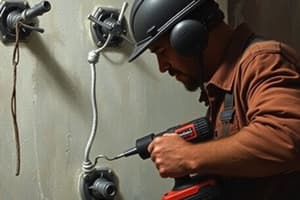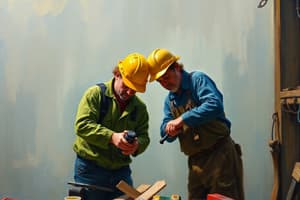Podcast
Questions and Answers
What is the primary use of a jigsaw?
What is the primary use of a jigsaw?
- Removing material quickly from rough surfaces
- Making straight cuts in sheets of wood
- Hollowing out areas in wood
- Curved or intricate cuts (correct)
Which feature is important for ensuring comfort during extended use of power tools?
Which feature is important for ensuring comfort during extended use of power tools?
- Power rating
- Weight and ergonomics (correct)
- Variable speed settings
- Type of motor
What type of safety equipment is recommended to protect eyes from debris while using power tools?
What type of safety equipment is recommended to protect eyes from debris while using power tools?
- Dust mask
- Safety goggles (correct)
- Ear protection
- Gloves
What should be done to maintain the performance of power tools?
What should be done to maintain the performance of power tools?
What is a key safety practice when using power tools?
What is a key safety practice when using power tools?
Why is it important to regularly clean power tools?
Why is it important to regularly clean power tools?
What aspect of a tool's power rating is critical for cordless models?
What aspect of a tool's power rating is critical for cordless models?
Which safety tip should be followed regarding clothing when using power tools?
Which safety tip should be followed regarding clothing when using power tools?
Flashcards are hidden until you start studying
Study Notes
Power Tools
-
Types of Power Tools:
- Drills: Used for making holes; can be corded or cordless.
- Saws:
- Circular Saw: Good for straight cuts in sheets of wood.
- Jigsaw: Best for curved or intricate cuts.
- Table Saw: Ideal for precise and straight cuts; requires a stable setup.
- Sanders:
- Orbital Sander: For finishing surfaces with a smooth finish.
- Belt Sander: For rapid material removal; used for rough surfaces.
- Router: Used for shaping edges and hollowing out areas in wood.
- Planer: Flattens and smooths wood surfaces.
-
Key Features to Consider:
- Power Rating: Measured in volts (V) for cordless tools or amps (A) for corded tools.
- Speed Settings: Variable speeds for different tasks.
- Weight and Ergonomics: Comfort during extended use.
-
Maintenance:
- Regularly clean tools to remove sawdust and debris.
- Check and replace worn-out blades and bits.
- Lubricate moving parts as needed.
Safety Practices
-
Personal Protective Equipment (PPE):
- Safety goggles to protect eyes from debris.
- Ear protection for loud tools.
- Dust mask or respirator to avoid inhaling sawdust.
- Gloves for hand protection, but choose wisely to avoid entanglement.
-
Workspace Safety:
- Keep the workspace tidy to prevent tripping hazards.
- Ensure proper lighting to see clearly.
- Avoid distractions while using power tools.
-
Tool-Specific Safety:
- Always read the manufacturer’s manual before using a tool.
- Unplug tools when changing accessories or making adjustments.
- Keep hands away from moving parts and blades; use push sticks for small pieces.
- Ensure guards are in place on saws and routers.
-
General Safety Tips:
- Wear close-fitting clothing, avoid loose garments.
- Use tools for their intended purpose only.
- Be aware of the tool's cord and potential hazards while using.
- Take regular breaks to maintain focus and avoid fatigue.
Power Tools Overview
-
Types of Power Tools:
- Drills: Essential for creating holes; available in corded and cordless versions.
- Saws:
- Circular Saw: Excellent for making straight cuts in large wood panels.
- Jigsaw: Specialized for intricate or curved cutting tasks.
- Table Saw: Delivers precise, straight cuts; requires a sturdy work surface.
- Sanders:
- Orbital Sander: Ideal for finishing tasks, achieving a smooth surface.
- Belt Sander: Designed for removing material quickly from rough surfaces.
- Router: Utilized for shaping edges and hollowing to create decorative profiles.
- Planer: Effective for flattening and smoothing uneven wood surfaces.
-
Key Features to Consider:
- Power Rating: Cordless tools rated in volts (V), corded tools in amps (A).
- Speed Settings: Variable speeds enable adaptation to different tasks.
- Weight and Ergonomics: Tools should be comfortable for prolonged use without causing strain.
-
Maintenance:
- Regular cleaning is essential to remove sawdust and debris build-up.
- Worn blades and bits need regular inspection and replacement.
- Lubrication of moving parts enhances performance and longevity.
Safety Practices
-
Personal Protective Equipment (PPE):
- Safety Goggles: Protect vision from flying debris.
- Ear Protection: Necessary for use of loud machinery to prevent hearing damage.
- Dust Mask or Respirator: Prevents inhalation of harmful sawdust particles.
- Gloves: Provide hand protection but should be chosen carefully to avoid entanglement risks.
-
Workspace Safety:
- Maintain a clean workspace to minimize tripping hazards.
- Ensure adequate lighting for visibility during tool operation.
- Avoid distractions to maintain focus when operating tools.
-
Tool-Specific Safety:
- Always review the manufacturer’s manual before tool use for safety instructions.
- Disconnect tools from power when changing accessories or making adjustments.
- Keep hands clear of moving parts and blades; use push sticks for safer handling of small wood pieces.
- Ensure protective guards on saws and routers are intact and functional.
-
General Safety Tips:
- Wear fitting clothing to prevent snagging; avoid loose garments while operating tools.
- Use tools solely for their intended purpose to avoid accidents.
- Remain aware of the tool's power cord and surrounding hazards during operation.
- Regular breaks help maintain concentration and reduce fatigue.
Studying That Suits You
Use AI to generate personalized quizzes and flashcards to suit your learning preferences.





